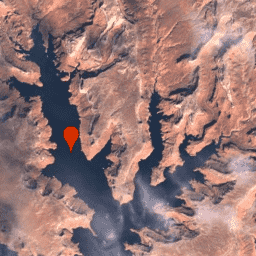Page Summary
-
This dataset contains 1-year composites created from all Landsat 7 images between 1999-01-01T00:00:00Z and 2014-01-01T00:00:00Z, excluding images with negative sun elevation.
-
The composites were generated using the ee.Algorithms.Landsat.simpleComposite() method with default settings.
-
The dataset includes reflectance data in bands B1, B2, B3, B4, B5, and B7, scaled to 8 bits, and temperature in band B6_VCID_2, converted to units of Kelvin-100.
-
Landsat datasets are in the public domain and can be used, transferred, or reproduced without copyright restriction, with acknowledgement of the USGS as the data source recommended.

- Dataset Availability
- 1999-01-01T00:00:00Z–2014-01-01T00:00:00Z
- Dataset Provider
- Tags
Description
These 1-year composites were created from all Landsat 7 images in the specified composite period, excluding images marked with a negative sun elevation in their metadata. The composites were created using the ee.Algorithms.Landsat.simpleComposite() method with its default settings. Reflectance ([0,1]) in bands B1, B2, B3, B4, B5, and B7 is scaled to 8 bits ([0,255]) and temperature in band B6_VCID_2 is converted to units of Kelvin-100.
Bands
Bands
| Name | Pixel Size | Wavelength | Description |
|---|---|---|---|
B1 |
30 meters | 0.45 - 0.52 μm | Blue |
B2 |
30 meters | 0.52 - 0.60 μm | Green |
B3 |
30 meters | 0.63 - 0.69 μm | Red |
B4 |
30 meters | 0.77 - 0.90 μm | Near infrared |
B5 |
30 meters | 1.55 - 1.75 μm | Shortwave infrared 1 |
B6_VCID_2 |
60 meters | 10.40 - 12.50 μm | High-gain Thermal Infrared 1. This band has higher radiometric resolution (sensitivity), although it has a more restricted dynamic range. Resampled from 60m to 30m. |
B7 |
30 meters | 2.08 - 2.35 μm | Shortwave infrared 2 |
Terms of Use
Terms of Use
Landsat datasets are federally created data and therefore reside in the public domain and may be used, transferred, or reproduced without copyright restriction.
Acknowledgement or credit of the USGS as data source should be provided by including a line of text citation such as the example shown below.
(Product, Image, Photograph, or Dataset Name) courtesy of the U.S. Geological Survey
Example: Landsat-7 image courtesy of the U.S. Geological Survey
See the USGS Visual Identity System Guidance for further details on proper citation and acknowledgement of USGS products.